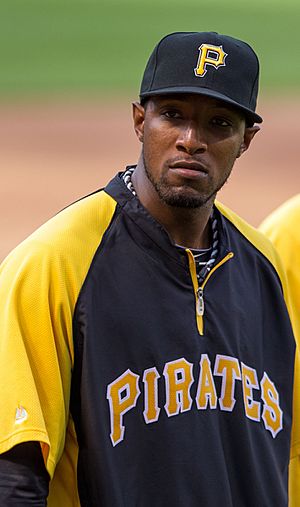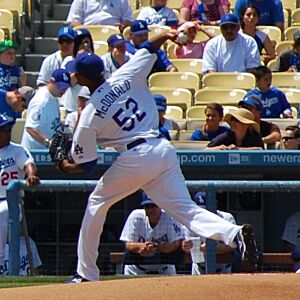James McDonald (baseball) facts for kids
Quick facts for kids James McDonald |
|||
|---|---|---|---|

McDonald with the Pittsburgh Pirates
|
|||
| Pitcher | |||
| Born: October 19, 1984 Long Beach, California, U.S. |
|||
|
|||
| debut | |||
| September 17, 2008, for the Los Angeles Dodgers | |||
| Last appearance | |||
| May 1, 2013, for the Pittsburgh Pirates | |||
| MLB statistics | |||
| Win–loss record | 32–30 | ||
| Earned run average | 4.20 | ||
| Strikeouts | 442 | ||
| Teams | |||
|
|||
James Zell McDonald, born on October 19, 1984, is a former professional baseball player. He was a right-handed pitcher in Major League Baseball (MLB). He played for the Los Angeles Dodgers and the Pittsburgh Pirates.
The Los Angeles Dodgers chose James in the 11th round of the 2002 MLB Draft. Before joining the Dodgers, he played college baseball at Golden West College in California.
Contents
Early Life and Sports
James McDonald went to Long Beach Poly High School. There, he played baseball, basketball, and football. He was good at playing in the infield and also pitching.
When the Dodgers first drafted him in 2002, they were more interested in him as a first baseman. But during his time in junior college, James's pitching skills got much better. This led the Dodgers to sign him as a pitcher.
Professional Baseball Journey
Starting with the Dodgers
James McDonald began his professional career in 2003. He pitched for the Gulf Coast Dodgers. He had a good start with a 3.33 ERA and 47 strikeouts.
Unfortunately, he had a problem with tendinitis that kept him from pitching in 2004 and most of 2005. During this time, he tried playing in the outfield. He thought he could still work on his arm while playing left field.
However, his batting average was low, so he decided to go back to pitching. He explained, "When I was in the outfield, I felt like I was just running around. I am a lot more competitive when I'm pitching, it's more up to me to get guys out."
In 2006, he returned to pitching full-time for the Columbus Catfish. He led the team's pitchers with a 3.97 ERA and 147 strikeouts.

James was named the Dodgers' Minor League Pitcher of the Year in 2007. In August 2008, he moved up to the Triple-A team, the Las Vegas 51s. He was called up to the Dodgers on September 1, 2008.
He made his first MLB appearance on September 17, 2008. He pitched one scoreless inning in relief against the Pittsburgh Pirates. In 2009, he earned a spot in the Dodgers' starting rotation. He made his first major league start on April 10, 2009.
After a few starts, he moved back to the bullpen. He pitched as a relief pitcher for the rest of the 2009 season. In 2010, he started the season with the Albuquerque Isotopes. He was called back up to the Dodgers in July 2010.
Time with the Pittsburgh Pirates
On July 31, 2010, James McDonald was traded to the Pittsburgh Pirates. He joined the Pirates along with outfielder Andrew Lambo. In his first game with the Pirates, he pitched 6 shutout innings. He also set a new personal best with eight strikeouts.
He said he was "real excited" to get a chance to start every five days. He pitched two complete shutouts in September 2010. His streak of 20 straight scoreless innings was the longest by a Pirates pitcher since 2005. His great performances made some people call him an "ace" for the Pirates. He finished 2010 with a 4–5 record and a 3.52 ERA for Pittsburgh.
2011 Season Highlights
In 2011, James had a strong May, with a 2.86 ERA. He allowed no more than three runs in any start that month. In July, he pitched two consecutive games without allowing any runs. He out-dueled Braves ace Tim Hudson in one game, striking out nine batters.
James talked about improving his control that season. He said, "Being ahead is a big key for me." This win helped the Pirates tie for first place in their division. He finished the 2011 season with a 9–9 record.
2012 Season Highlights
James started the 2012 season with several good performances. He earned his first win on April 30 against Atlanta. He pitched 7 and 2/3 innings and had 10 strikeouts. On May 17, he set a new personal record with 11 strikeouts against the Washington Nationals. He also had a no-hitter going into the sixth inning.
In May, he had a great record of 3–1 with a very low 1.54 ERA. On June 21, James pitched his first career complete game against the Minnesota Twins. He threw 120 pitches and allowed only one run. He had a strong 2.37 ERA before the All-Star break.
2013 Season
James McDonald was released by the Pirates on September 7, 2013. He became a free agent a few days later.
Chicago Cubs and Coaching
On February 13, 2014, James signed a minor league contract with the Chicago Cubs. However, he did not play in any games for the team due to an injury. He became a free agent again after the season.
In 2017, James McDonald started a new chapter in his career. He became a coach for the Southwest Nationals Baseball Organization. This organization was started by another former MLB pitcher, Scott Elbert.
Pitching Style
James McDonald used a variety of pitches when he was on the mound. His main pitch was a four-seam fastball, which traveled between 91 and 94 miles per hour. He also threw a two-seam fastball at a similar speed.
He had two breaking balls: a slider (79–82 mph) and a knuckle curve (75–77 mph). His final pitch was a changeup in the low 80s. James used his four-seam fastball about half the time. He often used his curveball when he was ahead in the count.
In 2012, his slider was recognized as one of the best "swing-and-miss" pitches in the National League. It had a very high whiff rate of 49% since 2011.
Family Connections
James McDonald comes from a family of athletes. His father, also named James, played basketball at USC. He also played football for the Los Angeles Rams from 1983 to 1987.
His uncle, Ben McDonald, was a professional basketball player for the Golden State Warriors. James also has cousins who played professional baseball: Darnell McDonald (former Chicago Cubs outfielder) and Donzell McDonald (former New York Yankee and Kansas City Royal outfielder).

